On Friday 27 September we left Northumberland and drove back down the A68, then we turned off to Escomb Saxon church – NZ 189301. A church literally in the middle of the village, surrounded by a circle of 1960s houses, parking outside, and the key hangs on a hook outside number 28. Church website – https://escombsaxonchurch.co.uk/, and it’s on https://www.explorechurches.org/church/escomb-saxon-church-escomb and http://www.greatenglishchurches.co.uk/html/escomb.html. They also mention a Small Pilgrim Places Network, which looks worth finding out more about – https://www.smallpilgrimplaces.org/
This church was built about 680 AD. Just mull that over – 680. When we read the Lindisfarne Gospels and think about Bede, this is a church that had been built when he was writing. Imagine all that this village has seen. Roman, Vikings, Prince Bishops, the building of the Stockton-Darlington Railway (terminus nearby at Witton Park), the coal mine and iron works, the decimation of industry in the 1960s and the building of the houses around it. It is a church that is still here, still used, still a place of prayer and worship – wow. T.S. Eliot wrote about “a place where prayer is valid” – it doesn’t come much more valid than here! To quote their guide “In its most simple and basic form the survival and continuity of this little church speaks of God’s eternal presence in the midst of our human frailty and transience.”


Having got the key I let myself in, ignored the displays in the porch, turned on the lights, and sat in the church itself just to soak up the atmosphere. Why was it built here? Who built it? Why is it so tall? I can’t see anything in the guidebook which suggests that the roof has been raised – so what does that say about a bunch of Saxons? They were perfectly capable of building to height and at height – I hope no one fell off the scaffolding while they did so. What does it say about their concept of the Glory of God, building their church so much higher than their houses? When the kids were little we lived near the Anglo Saxon Village at West Stow in Suffolk – well worth a visit – this church is on a different scale to those houses and halls.

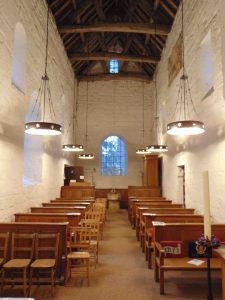
As you walk round the church there are various notices pointing out items of interest. The stone came from Binchester Roman Fort (the next blog) and you can see its origins. The stone next to east window in the north wall proclaims “Bono Rei Publicae Nato”, To the man born for the good of the State.


In the Chancel you can see The Tree of Life with a couple of figures (Adam and Eve) next to a blocked up door.


In front of the altar is a strip of Frosterley Marble, mined the other side of the Wear. The pattern in it was made by corals which grew in the warm, shallow sea which covered this area 180 million years ago. One assumes it is a grave cover, so the person underneath must have been of some importance. It would be wonderful to know who he was.

In front of the altar is a strip of Frosterley Marble, mined the other side of the Wear. The pattern in it was made by corals which grew in the warm, shallow sea which covered this area 180 million years ago. One assumes it is a grave cover, so the person underneath must have been of some importance. It would be wonderful to know who he was.



The piscina has a drain to ensure that the holy water does not get into the wrong hands. Nice solid chancel roof. The fresco on the chancel arch is C12, painted on to the plaster. You can imagine that most of the church would once have had these patterns and colours. There is a reference to the plaster work in 1697. Most of the frescos would have gone in the C19 when the church stood roofless for a while. The Victorian church (dedicated to St John the Evangelist) which replaced it, did not last as long as this chapel. Pevsner gives this church a dedication to St John, but the guidebook does not – nor does it link the church specifically with one of the Saxon saints we know about. Too often we (and northernvicar includes himself in this criticism) assume that faith depends on named individuals, amazing men (usually men) whose names we know. Rubbish! Although I will balance that with Kipling’s lovely poem – http://www.kiplingsociety.co.uk/poems_eddi.htm – on display in this church.
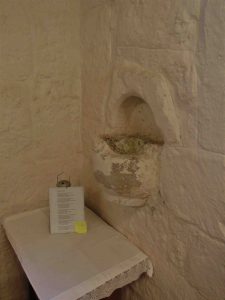
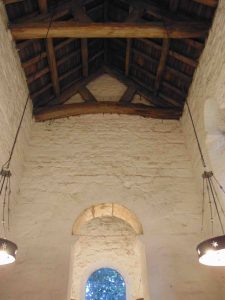

Let’s remember the generations baptised in this nice solid font (late medieval), and enjoy the Millennium Textile – made by local people, children from Escomb School and Durham City Embroiderers’ Guild under the leadership of Ann Clare.
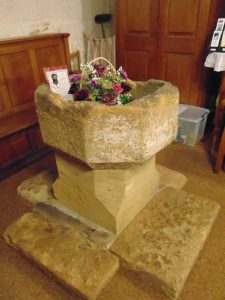

A good display in the porch – well worth a detailed read. I enjoyed this church!

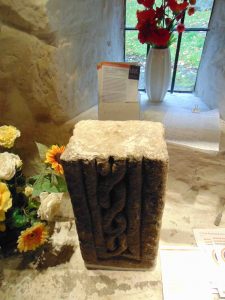

I went outside into a rather wet churchyard. This Celtic Prayer was displayed in church:
As the rain hides the stars,
As the autumn mist hides the hills,
As the clouds veil the blue of the sky,
So the dark happenings of my lot
Hide the shining of thy face from me.
Yet, if I may hold thy hand in darkness,
It is enough,
Since I know,
that though I may stumble in my going
Thou dost not fall.







